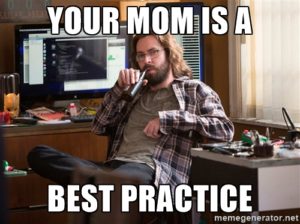Many people want to work in product management. One of the most common questions I receive is how to break into product management. It’s a hard question for me to answer, because 1) there is no default path (the same is true for trying to land a business development role), and 2) most of these people really don’t know what they’re asking for. My most common response is, “Are you sure? Product management can kind of suck.” The reason for the dichotomy of people who haven’t done product management finding it so alluring, and people who have done it cautioning people trying to get in is the difference between what I call a product visionary and the product leader.
Product visionaries are who we all hear about in the press. They are the people who come up with brilliant products that go viral or solve real needs in the market that no one else thought of. They appear to be masters of finding product/market fit. I’ve been lucky enough to work with a few of them in my previous jobs and a few in the portfolio at Greylock. These tend to be founder/CEOs, and they generate brilliant insights that create product opportunities others don’t see. Ev Williams is on his third breakout product in Medium after Blogger and Twitter. Ben Rubin created two products that hit product/market fit in two years with Meerkat and now Houseparty.
Anyone working in technology hears these stories, and they think the shortest path to that sort of glory is becoming a product manager. They are excited to get to a role where they can drive the vision of a product, even if it’s only one part of the company. This excitement is exacerbated by the commonly propagated myth that the product manager is the mini-CEO of their product. The reality is that in 90+% of cases, product management is not about being a visionary. It’s about being a leader.
What does a product leader do at a tech company? It’s actually very little of creating a vision and a strategy from scratch. It’s about helping everyone understand what the vision and strategy is. It’s about communicating to the entire team why the company is doing what it is doing. It’s about building a process that helps a team execute on that vision. It’s about when there are competing visions, aligning and motivating the team to focus on one, and getting people to disagree and commit (including sometimes yourself). It’s about looking at data to measure if product changes are having a positive impact on the customer and the company’s growth. It’s about talking to users to understand why they’re doing what they’re doing, and the problems they still face even though your product exists. It’s about mentoring more junior people on your team, across product as well as engineering, design, and analytics. And they don’t have to listen to you, so you have to use influence rather than authority to be successful.
In the scaling phase of a startup, it’s product leadership that drives performance, not vision. Vision is needed early to find product/market fit and plot a course to scale, and then the less that vision wavers over time the better. This vision is usually done by the founder/CEO. The reason founders hire product managers and VPs of Product is not to set vision, but to help execute the vision. Don’t get me wrong; that will sometimes mean coming up with solutions to problems your customers face. If a company is scaling by having the founders solve all the customers’ problems instead of product teams, it will struggle. But much of the time, it will be wrangling the ideas of the individual engineers, designers, and analysts on your team and matching that to an overall vision set by the founder(s). It’s very rarely your ideas you’re executing on as a product leader, and it shouldn’t be.
https://twitter.com/stevesi/status/943945949352665088
I also don’t want to make it sounds like I am devaluing visionaries. They are, of course, critical in finding the initial idea(s) that create a growing company and maintaining a vision for that growing company. Having visionaries also becomes more important as you saturate your core market and need to tackle new value propositions to drive new growth opportunities. That is the ideal time for non-founder visionaries to enter a growing company. These are not going to be typical product managers or VP’s though. They are usually ex-founders. The best outcomes for these people entering an organization that is scaling is giving them a team and space to experiment with ideas until they find their own product/market fit, where a business unit is built out around that vision with product leaders to help them scale.
As you’re thinking about your business, think about whether you need a product visionary or a product leader. Most founder/CEOs are already visionaries, so they need a product leader to help execute. Some businesses minded founders need the opposite to be successful. If you’re thinking about product management, think about whether what you really want to be a is product visionary instead of a product leader. In that case, it might be a better idea to start a company than take a role expecting to execute on your vision and instead managing other people’s visions.
Currently listening to Ambivert Tools Vol. 3 by Lone.







